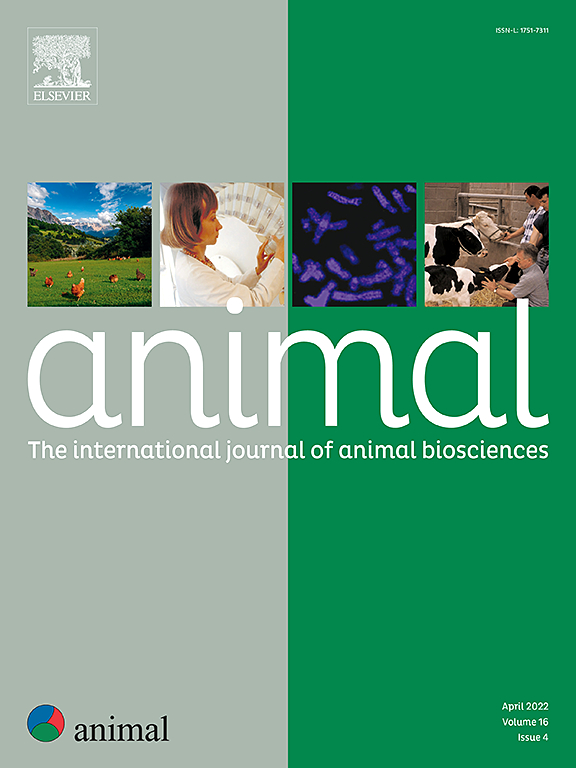Review: Cross-breeding, advanced reproductive technologies, and genetic selection in twelve dairy production systems in Africa
IF 4
2区 农林科学
Q1 AGRICULTURE, DAIRY & ANIMAL SCIENCE
引用次数: 0
Abstract
The supply and demand for milk in Africa have been rising due to factors such as population growth, urbanization, increasing incomes, and improved living standards. Dairy production significantly impacts the economic and social development of African countries, contributing over 10% to the agricultural gross domestic product in countries such as Ethiopia, Kenya, and Tanzania. The ongoing development of the African dairy industry can be attributed, to a certain extent, to the utilization of cross-breeding strategies and advanced reproductive technologies such as artificial insemination, embryo transfer, and the implementation of genomic selection programs. This review evaluates historical dairy breeding practices in twelve African countries and examines the use of advanced breeding tools to enhance and sustain cattle breeding programs across Africa. Eighteen cases from twelve African countries are reviewed to highlight the successes and reported positive impacts on dairy production, revenue, livelihoods, and genetic diversity. We have pinpointed the challenges of integrating new breeding approaches and technologies for African dairy programs, such as insufficient funding, low return on investment in biotechnology, poor monitoring and evaluation of breeding programs, and lack of developed legal frameworks on biotechnological operations. We have recommended strategies to overcome these barriers that may be employed in dairy systems to improve the adoption of breeding technologies across the region.
回顾:非洲十二个奶牛生产系统中的杂交育种、先进繁殖技术和遗传选择
由于人口增长、城市化、收入增加和生活水平提高等因素,非洲牛奶的供需一直在上升。乳制品生产对非洲国家的经济和社会发展产生了重大影响,对埃塞俄比亚、肯尼亚和坦桑尼亚等国的农业国内生产总值的贡献率超过10%。非洲乳业的持续发展在一定程度上可归因于杂交育种策略和先进生殖技术的利用,如人工授精、胚胎移植和基因组选择计划的实施。本综述评估了12个非洲国家历史上的奶牛育种实践,并检查了先进育种工具的使用情况,以加强和维持整个非洲的奶牛育种计划。本文回顾了来自12个非洲国家的18个案例,重点介绍了这些成功案例以及所报告的对乳制品生产、收入、生计和遗传多样性的积极影响。我们已经明确指出了将新的育种方法和技术整合到非洲乳制品项目中的挑战,例如资金不足、生物技术投资回报率低、育种项目监测和评估不到位,以及缺乏发达的生物技术操作法律框架。我们提出了克服这些障碍的战略建议,这些建议可用于乳制品系统,以改善整个地区育种技术的采用。
本文章由计算机程序翻译,如有差异,请以英文原文为准。
求助全文
约1分钟内获得全文
求助全文
来源期刊

Animal
农林科学-奶制品与动物科学
CiteScore
7.50
自引率
2.80%
发文量
246
审稿时长
3 months
期刊介绍:
Editorial board
animal attracts the best research in animal biology and animal systems from across the spectrum of the agricultural, biomedical, and environmental sciences. It is the central element in an exciting collaboration between the British Society of Animal Science (BSAS), Institut National de la Recherche Agronomique (INRA) and the European Federation of Animal Science (EAAP) and represents a merging of three scientific journals: Animal Science; Animal Research; Reproduction, Nutrition, Development. animal publishes original cutting-edge research, ''hot'' topics and horizon-scanning reviews on animal-related aspects of the life sciences at the molecular, cellular, organ, whole animal and production system levels. The main subject areas include: breeding and genetics; nutrition; physiology and functional biology of systems; behaviour, health and welfare; farming systems, environmental impact and climate change; product quality, human health and well-being. Animal models and papers dealing with the integration of research between these topics and their impact on the environment and people are particularly welcome.
 求助内容:
求助内容: 应助结果提醒方式:
应助结果提醒方式:


